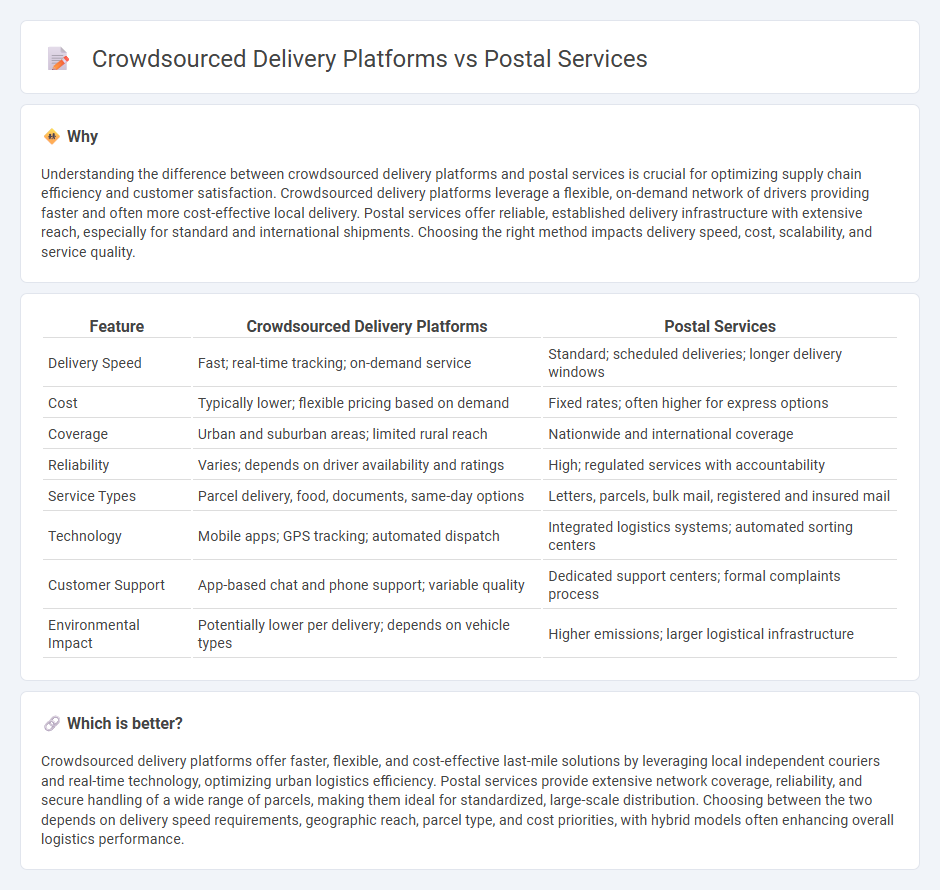
Crowdsourced delivery platforms leverage decentralized networks of independent drivers and gig workers to offer flexible, on-demand parcel delivery, contrasting with traditional postal services that rely on established infrastructure and scheduled routes. This innovative model reduces delivery times and increases efficiency, particularly in urban areas with high demand density. Explore how these two approaches reshape the future of last-mile logistics.
Why it is important
Understanding the difference between crowdsourced delivery platforms and postal services is crucial for optimizing supply chain efficiency and customer satisfaction. Crowdsourced delivery platforms leverage a flexible, on-demand network of drivers providing faster and often more cost-effective local delivery. Postal services offer reliable, established delivery infrastructure with extensive reach, especially for standard and international shipments. Choosing the right method impacts delivery speed, cost, scalability, and service quality.
Comparison Table
| Feature | Crowdsourced Delivery Platforms | Postal Services |
|---|---|---|
| Delivery Speed | Fast; real-time tracking; on-demand service | Standard; scheduled deliveries; longer delivery windows |
| Cost | Typically lower; flexible pricing based on demand | Fixed rates; often higher for express options |
| Coverage | Urban and suburban areas; limited rural reach | Nationwide and international coverage |
| Reliability | Varies; depends on driver availability and ratings | High; regulated services with accountability |
| Service Types | Parcel delivery, food, documents, same-day options | Letters, parcels, bulk mail, registered and insured mail |
| Technology | Mobile apps; GPS tracking; automated dispatch | Integrated logistics systems; automated sorting centers |
| Customer Support | App-based chat and phone support; variable quality | Dedicated support centers; formal complaints process |
| Environmental Impact | Potentially lower per delivery; depends on vehicle types | Higher emissions; larger logistical infrastructure |
Which is better?
Crowdsourced delivery platforms offer faster, flexible, and cost-effective last-mile solutions by leveraging local independent couriers and real-time technology, optimizing urban logistics efficiency. Postal services provide extensive network coverage, reliability, and secure handling of a wide range of parcels, making them ideal for standardized, large-scale distribution. Choosing between the two depends on delivery speed requirements, geographic reach, parcel type, and cost priorities, with hybrid models often enhancing overall logistics performance.
Connection
Crowdsourced delivery platforms enhance postal services by expanding last-mile delivery capabilities through a network of independent drivers and local couriers, reducing delivery times and operational costs. Postal services leverage these platforms to manage fluctuating demand efficiently, improve route optimization, and increase service coverage in urban and rural areas. This collaboration integrates real-time tracking technologies and digital communication, ensuring seamless package handling and customer satisfaction.
Key Terms
**Postal Services:**
Postal services offer reliable nationwide coverage with established infrastructure, ensuring consistent delivery of letters and parcels through government or licensed carriers. These services maintain standardized tracking, security protocols, and delivery timelines, particularly excelling in rural and remote locations where crowdsourced platforms may lack presence. Explore how postal services continue to innovate and maintain trust in an evolving logistics landscape.
Mail Sorting
Mail sorting in postal services relies on automated machinery and established logistical frameworks to ensure accuracy and efficiency in processing high volumes of mail. Crowdsourced delivery platforms leverage decentralized networks and real-time data to dynamically organize and sort mail based on proximity and delivery routes. Explore how innovative technologies are reshaping mail sorting efficiency within these delivery models.
Delivery Routes
Postal services rely on fixed delivery routes optimized for consistent geographic coverage and scheduled drop-offs, ensuring reliability and systematic parcel handling. Crowdsourced delivery platforms utilize dynamic routes driven by real-time demand and driver availability, enabling flexible and rapid last-mile delivery. Explore how these delivery route strategies impact efficiency and customer satisfaction.
Source and External Links
United States Postal Service - Wikipedia - The United States Postal Service (USPS) is an independent agency of the U.S. federal government that provides postal services including letter and package delivery, having a monopoly on traditional letter delivery within the U.S. but competing in package delivery with private carriers like FedEx and UPS.
U.S. Postal Service (USPS) | USAGov - USPS offers mail processing and delivery services for individuals and businesses, providing customer support, tracking, and a wide network of post office locations across the United States.
USPS Shipping Services - Postal Center - Postalcenter(r) provides comprehensive USPS shipping options including domestic and international services such as Express, Priority, First Class, and Ground shipping, along with packing guarantees and support through delivery.
 dowidth.com
dowidth.com